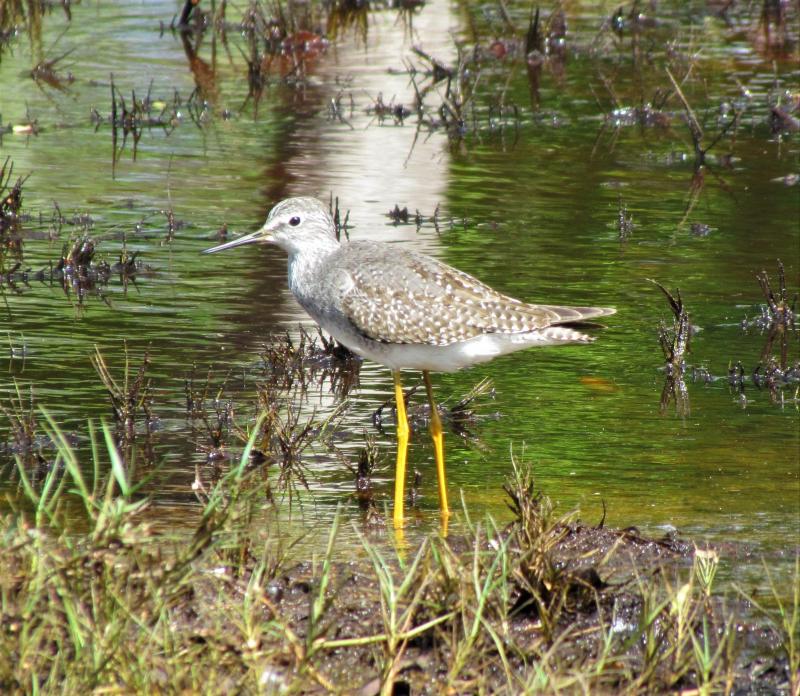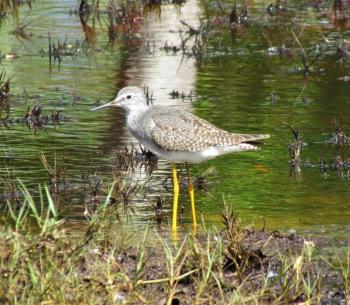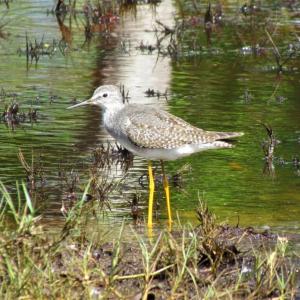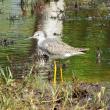Legs of Yellow
There are few birds so well named as the two species of long-legged sandpipers called the “yellowlegs.” Their bright yellow legs are indeed a feature that is particularly noticeable given their otherwise gray and white plumage. Fitting nicely into what we would expect from the rest of their names, the larger of the two species is called the greater yellowlegs and the smaller, the lesser yellowlegs. Both species of yellowlegs are among a small set of birds of the sandpiper family that nest south of the Arctic in the Boreal Forest region of Canada and Alaska.
Greater yellowlegs nest less than 400 miles north of Maine’s Midcoast region, occupying much of the Boreal Forest region of Quebec and east to Newfoundland and west all the way to southern Alaska. Lesser yellowlegs nest a little farther north (about 650 miles from us), reaching northwestern Quebec around James Bay and with the breeding range extending west to interior Alaska. Both species nest on the ground, often in or near bogs, and lay clutches of 3-4 eggs.
Both species arrive as early as April on the Maine coast after wintering somewhere between the southern U.S. and South America. After refueling in our coastal estuaries, they continue north to the breeding grounds. Amazingly, good numbers of yellowlegs begin arriving back along the coast of Maine on their way south in July. The ringing “tu-tu-tu” calls of the greater yellowlegs become a familiar sound if you are near the water in July and August.
Those same sounds were once eagerly awaited by commercial bird hunters. Thousands of yellowlegs were taken by market hunters along the coast of the U.S. during their migration periods. Using big “cannon” guns, it was sometimes possible to kill dozens and occasionally as many as 100 in a single shot. These and other shorebirds, including golden and black-bellied plovers, and the now-extinct Eskimo curlew, were commonly available in markets and sometimes in restaurants.
But the slaughter stopped when the Migratory Bird Treaty Act became law in 1918. Only limited shorebird hunting was allowed after that, and soon the hunting of all shorebirds except American woodcock and Wilson’s snipe was banned. Most shorebirds saw a rebound in populations after this, although numbers of many shorebird species are thought to have declined again in recent decades. Shorebird hunting still occurs in parts of the Caribbean and perhaps in South America but today’s declines are more likely the results of habitat loss and degradation, pollution, and contaminants.
Still, the fact that we can hear the calls of yellowlegs echoing around our favorite cove as the tide recedes on a warm, late summer evening, is because of the forethought and persistence of bird lovers a hundred years ago. They ushered through the Migratory Bird Treaty, and then the legislation to enact it in the U.S. and Canada. In 2018, the Year of the Bird, we remember them and thank them!
Jeffrey V. Wells, Ph.D., is a Fellow of the Cornell Lab of Ornithology. Dr. Wells is one of the nation's leading bird experts and conservation biologists and author of the “Birder’s Conservation Handbook.” His grandfather, the late John Chase, was a columnist for the Boothbay Register for many years. Allison Childs Wells, formerly of the Cornell Lab of Ornithology, is a senior director at the Natural Resources Council of Maine, a nonprofit membership organization working statewide to protect the nature of Maine. Both are widely published natural history writers and are the authors of the popular book, “Maine’s Favorite Birds” (Tilbury House) and the just-released “Birds of Aruba, Bonaire, and Curaçao” from Cornell University Press.
Event Date
Address
United States


























